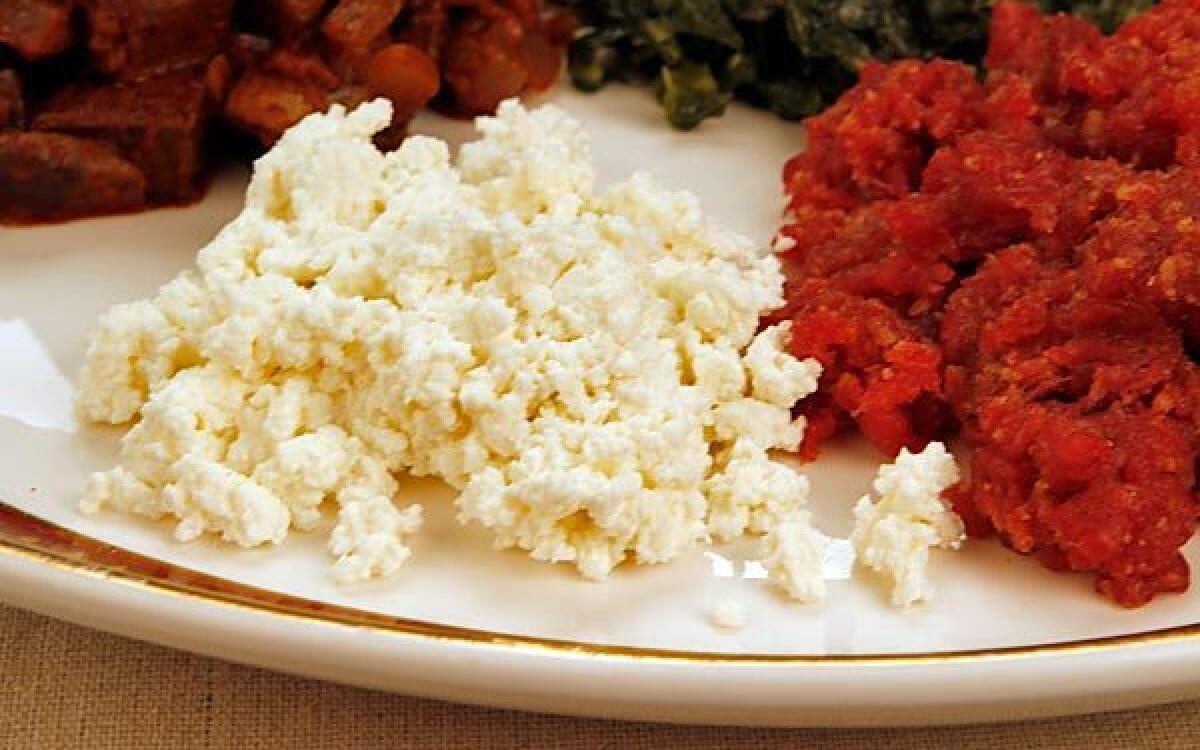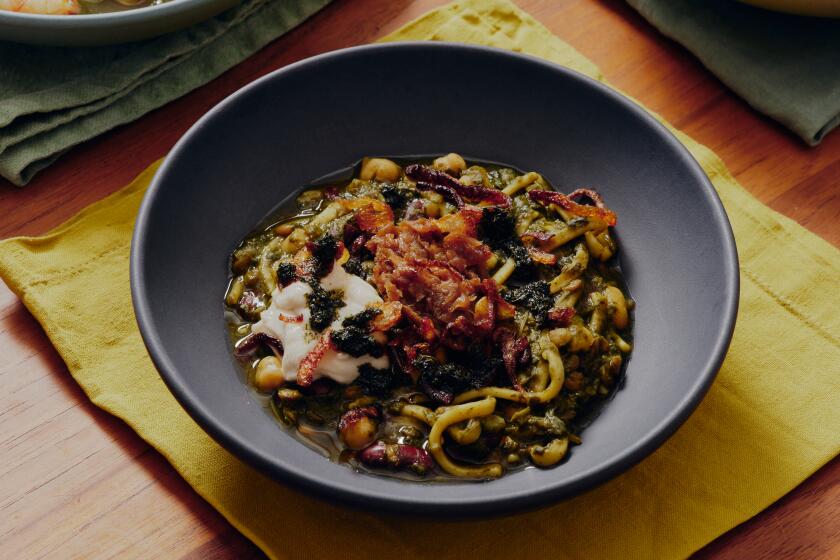Ayib

When tourist James Barker had dinner at the home of his Ethiopian hosts, he knew he’d have to be polite and eat whatever indigenous cuisine they offered him. He didn’t know it wouldn’t be cooked.
Ethiopia is “a nation who generally live[s] on raw meat, and it cannot be supposed that they have made great advancement in their cuisine,” the Briton wrote in “Narrative of a Journey to Shoa,” an 1868 account of his Ethiopian odyssey.
Nearly a sesqui-century later, it looks like Barker was prescient. Ethiopian restaurants in America often tout their vegan options, and Ethiopians certainly appreciate their culture’s vegetarian cuisine. But they relish meat even more, and if it’s not a holiday fasting season, during which meat is forbidden, they hungrily embrace beef -- sometimes cooked, sometimes not.
The recipe for raw beef hasn’t changed much since Barker’s visit. And how could it? Raw is raw, no preparation required. You melt some Ethiopian butter ( niter kibe), combine it with freshly ground beef, toss in the requisite spices and voila, it’s what’s for dinner -- a favorite Ethiopian dish called kitfo.
Unless, of course, you don’t fuss with all of that. Just take some bite-sized chunks of raw beef, dip them into the red pepper paste awaze or the even hotter red pepper powder mitmita, and you’re feasting on gored gored, most likely the no-frills meal that so repelled Barker.
The even simpler tere siga, or “raw meat,” requires no preparation at all: Presented with long strips of meat, the gourmand uses a knife to cut off piece after piece. This ritual is called q’wirt, from the Amharic word q’warata, to cut.
Ayele Solomon, a businessman who lives in Addis Ababa, the Ethiopian capital, prefers to eat the most basic version, tere siga, so he can serve himself.
“The cutting is part of the ceremony,” says Solomon. And besides, he adds, “you don’t want someone else’s filthy hands touching it.”
Solomon, an American citizen, was born in Ethiopia and lived in the Bay Area, where his family still lives, from ages 11 to 22. He remembers eating raw meat for the first time as an older teenager in his family’s kitchen, where he “just grabbed a piece and put it into my mouth.”
In Ethiopia, Solomon says, eating raw meat tends to be a “male thing” that guys might do together.
Ethiopian tere siga typically comes from grass-fed beef, Solomon says, which gives it a different flavor and texture.
“In America, [the meat is] grain-fed, and it’s more watery because they try to fatten the animal. In Ethiopia, the flavors are concentrated. An extreme example would be like eating a grape versus a raisin.”
There’s plenty of Ethiopian literature going back centuries to document dishes like tere siga and gored gored. But James McCann, a professor at Boston University and the author of “Stirring the Pot,” a book about African cuisine, believes kitfo is a modern variant.
“Expatriate Ethiopians have lots of cultural myths that claim historical background,” McCann says, “but they really only date from the Addis Ababa elite or upper-middle-class practice in the mid-20th century. Kitfo is a fairly recent addition to the urban diet. Raw beef cut in chunks or strips has been around for a long time.”
Kitfo is the most common version of raw meat served at Ethiopian restaurants in the U.S. It came to the table from the Gurage people, who make up about 2.5% of the population of Ethiopia, a country with more than 80 indigenous languages.
Angeleno Berhanu Asfaw grew up in the Gurage town of Muher, Ethiopia, and he ate his kitfo raw from about the age of 5 or 6, when children are judged to be safe enough from the effects of parasitical worms and other food-born illnesses that they are first allowed to eat raw meat.
At Meskel, an Ethiopian Orthodox Christian holiday, children go from home to home, greeting the elders, and at each stop their hosts have kitfo prepared especially for them.
Now Asfaw serves kitfo and gored gored at Messob, the restaurant in Los Angeles’ Little Ethiopia on Fairfax Avenue that he co-owns with his brother Getahun. The menu describes the beef as “lean” but doesn’t mention raw, so his servers ask patrons how they want it. Non-Ethiopians usually like it to be cooked just a little, but Asfaw’s Ethiopian customers prefer it raw.
Most of the city’s Ethiopian restaurants offer kitfo, but like Messob, they don’t all describe it as raw on their menus. If you want your kitfo slightly cooked -- what Americans would call rare -- ask for it lebleb. Fully cooked is yebesele.
Asfaw recommends lean cuts of meat, like top round, for raw beef dishes, and Messob grinds the meat for kitfo fresh, often right when it’s ordered. “You can’t even grind it and keep it the whole day and serve it in the evening,” he says, because it loses its flavor.
At Selam Market and Deli on West Pico Boulevard, Samuel Mekonnen sells more meat for kitfo than for any other raw dish, and he grinds it fresh at his market’s butcher shop.
He too recommends very lean cuts like top round, ball tips or even the costlier rib-eye.
“If you try to eat soft meat as raw meat, it doesn’t taste as good. It has to be firm,” says Mekonnen, who co-owns the market with his wife, Amsalework Jemberu.
Mekonnen says women enjoy raw meat just as much as men do, although they tend to eat it more at family gatherings. When men gather at a tej bet -- that is, a place that serves tej, the Ethiopian honey wine -- women don’t usually join them.
The traditional accompaniment for kitfo is gomen, or collard greens, and it always comes with a side of ayib, the soft Ethiopian cheese. Of course, you eat it all by hand with injera, the spongy Ethiopian sourdough flatbread that serves as plate and cutlery.
Among Gurages in Ethiopia, though, injera is a rare accompaniment. Gurage culture eats raw meat with qocho, a bread-like food made from the bark of the enset plant, a staple among many Ethiopian cultures. Enset is almost impossible to get in the U.S., so you won’t find qocho at many restaurants. But it’s become very popular back home, and some restaurants in the Washington, D.C., area now import fully prepared qocho to accompany their kitfo.
Asfaw enjoys tere siga in the U.S., but for health reasons he no longer eats it when he visits Ethiopia. He remembers talking to his grandfather back home about his culture’s love of raw meat. The reasons, he learned, were both practical and primal.
“When they had different wars, a long time ago, it was just easier to kill something and eat tere siga,” Asfaw recalls his grandfather telling him. “It also makes you more macho, and they like that. You have a lot of things that aren’t cooked over there.”
In a deep, heavy-bottom saucepan, heat the yogurt over low heat until it comes to a gentle boil. Continue to boil until the yogurt separates, about 15 minutes (you will be able to see the solid white curds separating from the yellowy liquid whey).
Remove from heat and very gently pour (or strain) off the whey. Place the soft cheese into a covered container and set it aside to cool. This makes 1 generous cup ayib. Refrigerate the cheese after using; it will keep, refrigerated, for up to 1 week.
Get our Cooking newsletter.
Your roundup of inspiring recipes and kitchen tricks.
You may occasionally receive promotional content from the Los Angeles Times.














